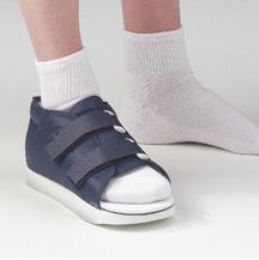





.jpg&newheight=260&quality=80)






~1.jpg&newheight=260&quality=80)

~9.jpg&newheight=260&quality=80)

What is a Post-Op Shoe?
After most foot surgeries, patients are usually told to not immediately walk on their feet in order to allow the foot to heal to a point when weight-bearing movement or rehabilitation is appropriate and required. When the patient is able to start the walking or rehab stage of recovery, a post-operative shoe is recommended to protect and support the patient’s surgically repaired foot, and to aid the healing process.
Designed to provide the foot with protection and support, the post-op shoe should be large enough to fit over post-surgical bandages or casts. They are specifically configured to open up to easily fit the foot into it, allowing easy access of the foot to check on bandages. The shoe will act like a “bumper” to prevent injury when walking, and usually have a rigid sole so the surgical site does not move and flex, causing trauma and swelling. When wearing a post-op shoe, it is advisable to wear a shoe with a lift on the opposite foot, like a boot, clog or mule type of shoe, to balance out the leg length and prevent back pain.
Who Would Wear a Post-Op Shoe?
Post-op shoes provide the necessary compression, protection and security for patients recovering from different things such as broken toes, foot ulcers, post bunion surgery, and bandage/cast protection, and especially for geriatric patients and diabetic patients with insensitive feet.
Some other reasons why individuals would wear a post-op shoe include:
Forefront surgical procedures:
Austin bunionectomy
Great toe joint arthritic bone spur removal
Great toe joint implant
Kellar bunionectomy
Akin bunionectomy
McBride bunionectomy
Tailors Bunion
Excision of Interdigital Neuroma
Metatarsal Osteotomy
Hammertoe surgery
Excision of ganglionic cyst
Foot fractures and fusions:
Lepidus bunionectomy
Base wedge bunionectomy
Great toe joint arthrodesis
Metatarsal and digital fracture repair
Reconstructive procedures:
Talar fractures
Ankle fractures
Triple arthrodesis
Lisfranc fractures
Calcaneal fractures
Subtalar joint fusion
Brostrum procedure
Peroneal, achilles tendon repair, or posterior tibial
Repair of ankle osteochondral defect
Achilles tendon lengthening
Flat foot reconstruction
How Should a Patient Wear a Post-Op Shoe?
After being fitted with a post-op shoe, unless otherwise instructed by a medical professional, patients should wear the shoe when they’re up and walking. During the day, they should remove the shoe and inspect the skin twice a day. There may be some redness on the skin from the pressure areas caused by the shoe. While this is to be expected, if the redness lasts for more than fifteen minutes after removing the shoe, then this could be a sign of excessive pressure. If this happens, or any signs of tingling, numbness, excessive itching, color change of the foot, pain or swelling occur, patients should contact their doctor for an adjustment to avoid persistent discomfort and skin irritation. The post-op shoe should be worn with a sock, and the straps on the shoe should be snug but not tight. Use a shoe with a lift or a thicker sole on the opposite foot to help balance the leg lengths in order to provide maximum support and stability.
Hulet Smith, OT
Rehabmart Co-Founder & CEO
ws